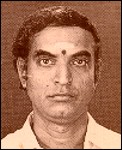

KARAIKUDI R. MANI

The Morsing


KARAIKUDI R. MANI

The Morsing
Andrián Pertout speaks to mridangam maestro Karaikudi R. Mani and morsing player Srirangam S. Kannan about the South Indian 'Carnatic' Jew’s harp tradition.
In the South Indian ‘Carnatic’ classical music tradition, the mridangam (double-headed barrel drum) is regarded as ‘the king of percussion instruments’, and so features as the main instrument of the percussion ensemble. It therefore also serves as the central base for the study and application of the ‘tala’ or rhythmic foundation of Indian music. The kanjira (frame drum), ghatam (claypot) and morsing (Jew’s harp) on the other hand have the lesser roles of side accompaniments. Karaikudi R. Mani, a former student of Sri Karaikudi Rangu Iyengar, T. R. Harihara Sharma and Sri K. M. Vaidyanathan is today one of South India's most popular mridangam players, and duly a celebrated and respected composer, performer and educator. Srirangam S. Kannan, who began playing the morsing at the relatively late age of thirty-three, is one his supporting musicians. He trained under mridangamists Kanadukathan Rajaram and Pudukottai Mahadevan, and later with Karaikudi R. Mani, where he perfected the techniques of the art of ‘Konnakol’, being the percussive vocal technique of the mridangamists.
How did music initially enter your life?
SSK: ”Actually, my family is not a musical family. I only learnt this art at the age of thirty-three. I was working in a bank, and had a friendship with one of the top Muslim artists, Kanadukathan Rajaram, so I learnt this art from a mridangamist, Pudukottai Mahadevan, and then from him. And I was then very fortunate to be asked to play this concert in the year 1986. And after being trained rigorously under Karaikudi R. Mani, I was able to play most things, in different styles.”
Tell me about the instrument that you play. What is the morsing?
SSK: ”The morsing is basically a lyre instrument, a Jew’s harp. And it’s not an Indian instrument, it comes from Greece.”
KRM: ”The Indian variety is hand made, and available only in the countryside. So only one or two people are involved in the manufacturing. And you can see in the instrument design that in the centre, at the top and bottom there is a half circle. There is also a hole there, and in the centre there is a small reed. The tip of the reed is round, and we can adjust the basic pitch, a little higher or lower by applying wax to the tip.”
When did South Indian musicians begin using the morsing?
KRM: ”About sixty or seventy years ago. And you know, like the ghatam (claypot) someone wrongly said that it was a divine instrument, but it’s not, because that instrument was only used in folk items, the folk songs in the countryside, in the village. But then somebody tried to adopt this, ‘Why not use this instrument in Carnatic music.’ And like this the Jew’s harp was also adopted, and it’s been used for only a very short time. And the cost of the instrument is very low; you can even buy it for one Australian dollar. But there are no players, only very few players. So demand is not great, and we have to make an order for them to be made. And we use many, because there are different pitches we have to select, and also because sometimes you break them.”
How would you describe its primary function in South Indian ‘Carnatic’ music?
KRM: ”It is mostly being used now in percussion ensembles, and by some musicians that like this sound. So they include it in their concerts, but not very much, occasionally. And it’s used as a percussion instrument, but never on it’s own, in a solo section along with mridangam, not a separate solo. Like on my CD, as a side accompaniment to the mridangam, together with kanjira and ghatam.”
What are some of the playing techniques utilized in your Jew’s harp tradition?
SSK: ”I suck the air inside, and also spell syllables. ‘Taga, taga, taga dam,’ like that, ‘Tom, taga, taga taga dam’. So there is a normal tone, another where I suck the air, and sometimes one where I also blow the air. I place the instrument between the teeth, resting on the lower portion, and speak the syllables through the tongue.”
KRM: ”And you have to say them without producing sound.”
How do you incorporate traditional rhythmic forms into morsing performance?
SSK: ”The patterns are mridangam syllables.”
KRM: “He has learnt them from me and other mridangamists. So really, he had to learn how to play and also how the syllables work. So accompanists know everybody’s syllables. And the set patterns are fixed, although here and there he can improvise, but because so many people are playing at once, some of these things have to be set, we have to practice them. Our Carnatic music has a boundary, a big fence, but you can travel anywhere within that fence.”
For further information write to C/- Karaikudi R. Mani, The Sruthi Laya Seva Trust (Centre of Percussion Art), 14 Layapriya, Jeth Nagar 1st Main Road, R.A. Puram, Madras 600028, India, or visit the Art India Web Site: Karaikudi R. Mani.
ANDRIÁN PERTOUT
'Mixdown' Monthly ~ Issue #71, March 1, 2000
BEAT MAGAZINE PTY LTD
All rights reserved. All text,
graphics and sound files on this page are copyrighted.
Unauthorized reproduction and
copying of this page is prohibited by law. Copyright © 2000 by Andrián
Pertout.
![]()
Karaikudi R. Mani: Mridangam Maestro
![]()
Karaikudi R. Mani